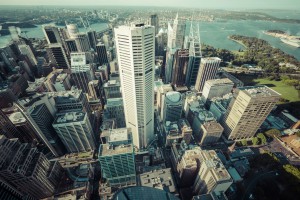Australia has overtaken the US as titleholder for “home to the world's largest houses”
Large McMansions on expansive suburban blocks have long been held as the ideal “Great Australian Dream”, while smaller inner city apartments copped a pretty bad rap as the cheap and nasty end of the property market.
However times are changing, with many home buyers and tenants forced to reflect on whether their priority is square footage and a big backyard in the burbs or getting into a property without breaking the budget.
Suddenly that one bedroom apartment seems a lot more appealing.
Whilst many developed countries have embraced the virtues of high-density accommodation clustered around major cities; think New York, Paris, London and Tokyo; here in Australia, our culture has been based on backyards, BBQ's and wide-open family spaces.
Now though, a demographic shift is occurring, with more single person households and childless couples choosing to live in and around our big cities where employment and lifestyle factors are big draw-cards.
Figures from the Australian Bureau of Statistics (ABS) reveal that the number of one person households will surge to between 3 million and 3.6 million by 2031; a dramatic shift when you consider that in 2006 only 1.9 million people lived alone.
This massive increase is due to a number of factors including;
- Gen-X'ers downsizing as their children leave the family home.
- a forecast jump in the number of DINKS (Double Income No Kids).
According to the ABS couple-only households are set to overtake the number of families with offspring in the next two or three years, and it's expected that DINKS will make up 60 per cent of all couple-only households by 2031. - a rapidly growing population and continuing housing shortage in some of our major cities.
- ongoing affordability issues and increasing rental prices forcing many to rethink their size requirements.
Demand for one bedroom apartments, which skeptics have long considered to be less desirable, is set to soar as many Australians adjust their ideals according to what they can afford.
And one of the questions they'll be asking is; do I really need that extra bedroom?
In the past singles and couples have, by and large, sought out two bedroom apartments with the perception that they offer larger living spaces and the convenience of extra storage.
However with price tags for such real estate heading upwards of $550,000 in Melbourne and %700,00 in Sydney and rents soaring over $500 per week in many desirable locations, the affordability barrier is encouraging many tenants, investors and homebuyers to accept one bedroom units as a viable alternative.
Recognising this growing trend, developers are jumping on the bandwagon and including more one bedroom units in their large scale projects.
But be wary…
The price of many of these new apartments is going up as their size is going down.
So do one bedroom apartments make good, affordable investments?
Is there enough ongoing future demand from tenants and owner occupiers alike to ensure they perform as long term cash cows?
The simple answer is - yes!
Why?
Because affordability means more owner occupier buyers will be pushed into this type of real estate as they sacrifice size for location, thereby increasing demand and placing upward pressure on prices.
These apartments are often located closer to the city and major work nodes as well as universities and hospitals, in areas that generally have efficient transport connections, plenty of retail facilities and social amenity; all key elements high on the list of young buyers.
In addition, tenants seeking rental accommodation in and around desirable lifestyle locations will look for affordable one bedroom alternatives, meaning investors will have a large tenant pool to help pay the mortgage.
Sure, one bedroom accommodation caters to a narrow demographic of one and two person households, but the reality is this is a mismatch of the demand from this growing demographic and the relatively restricted supply of established one bedroom apartments that are “investment grade” properties.
I have to say that some of my best performing investments over the last few years have been one bedroom apartments.
They attract a diverse range of tenants, including Gen Y's making the break from mum and dad; young professional couples, middle aged singles as well as downsizing baby boomers.
A few words of warning:
Not all apartments make good investments...
- Steer clear of new and off the plan developments, especially in the CBD’s of our major capital cities.
Especially in Melbourne where there is a huge oversupply of CBD apartments and Brisbane with a potential oversupply problem.
George Raptis has recently written why inner CBD apartments make terrible investments and I've written why I'm worried about the Melbourne inner CBD apartment market and how more apartments are being built in Melbourne than ever before.
Small spaces can either be highly functional or incredibly pokey meaning the design and layout of your apartment is critical.
- Avoid studio apartments. They are too small, the banks don't like them and they are very hard to on sell.
Instead go for something that offers at least 50 square metres of indoor space and if you can manage a balcony and plenty of clever storage options, all the better.
Off street parking is a desired bonus, but not necessarily required if close to transport
- Avoid the large generic developments sold off the plan in the center of major cities.
While these might seem shiny and new, they quickly lose their lustre when people realise they lack character and the timeless appeal that puts property in continuous strong demand.
Usually the majority of buyers in these soulless complexes are investors, while owner occupiers - the true driving force behind real estate values - tend to stay well away in preference of something more established or in a boutique block.
With overseas investors making the bulk of the purchases in these buildings I can see huge problems looming in the future. Imagine the Owner's Corporation meetings - with mainly overseas investors who are unlikely to want to spend money maintaining the building.
How is the Body Corporate manager ever going to chase up their fees if they refuse to pay?
Also...many of these have been built to a very poor standard and are likely to be the slums of the future.
In fact a recent report revealed that many of Melbourne's tiny apartments would be banned in New York, while another report estimated that 55 per cent of the city’s tallest apartment buildings are of “poor” quality, with common design flaws.
However there are many well designed established 1 bedroom apartments in our inner ring (not CBD) suburbs that make great investments, so next time you're shopping for an investment remember that it's not the size of the property that counts, it's the size of the profit you'll realise at the end of the day!
This means...
YOU MUST BUY INVESTMENT GRADE PROPERTIES
If you’ve been following my blogs you’d know I believe that less than 1% of properties are “investment grade” properties – ones that will outperform the averages in the long term.
At Metropole we use a 6 Stranded Strategic Approach to property selection:
- We buy properties that appeal to owner occupiers, as owner occupiers make up the bulk of property purchasers and push up the value of certain types of property.
- We buy a property below its intrinsic value – that’s why we avoid new and off the plan properties which come at a premium price.
- We look for proeprties with a high land to asset ratio. This just doesn't apply when developers build high rise towers, but many established apartments (what we used to call flats) fit the bill
- In an area that has a long history of strong capital growth and that will continue to outperform the averages because of the demographics in the area. This will be an area where more owner occupiers will want to live because of lifestyle choices and one where the locals will be prepared to, and can afford to, pay a premium price to live.
- We look for a property with a twist – something unique, or special, or different or scarce about the property, and finally
- A property where we can manufacture capital growth through refurbishment, renovations or redevelopment.
By following this 6 Stranded Strategic Approach, we minimise the risks and maximise the upside.
Each strand represents a way of making money from property and combining all five is a powerful way of putting the odds in our favour.
If one or two strand lets us down, I have three or four others supporting our property’s performance.
If you’d like some independent unbiased advice about getting started in property investment, or for one of Metropole’s property strategists to review your existing portfolio click here and organise a free strategic property portfolio review




















